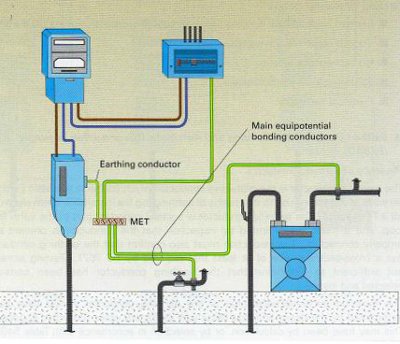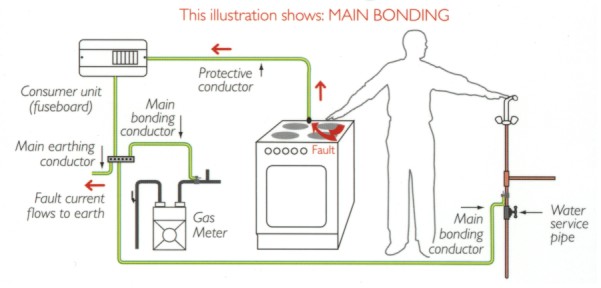

Main Bonding (Earthing)
Main Bonding is the use of a separate thick (10mm) green and yellow copper cable, to connect the Water, Gas and Oil services to the Earth Terminal in or adjacent to your consumer unit. Connections are made on the metal pipes near the point at which they enter your home, i.e. The Main Bonding for the water is normally connected within 600mm of your Water Stop Tap.Main Bonding is there to protect you. A fault current (amps), but if is easy to understand in volts think of it in that way instead, will always try to find a path down to earth, literally to the ground. The current will always take the easiest path to ground; the idea of Main Bonding (and Supplementary Bonding) is to create an alternative path for the current to flow that is an easier path than along one of your heating pipes, along your arm, through your body, down your legs to the wet kitchen floor and to ground. By using a thick copper cable, you are creating a path that is more inviting to any fault currents and will divert any fault currents from your body or places where it should not go, as the current flows down to ground.

As long as the Water pipe, Gas pipe or Oil pipe, coming into your property are metallic, Main Bonding is compulsory in all circumstances even when the rest of the pipes in your house are plastic.
Supplementary Bonding
Supplementary Bonding is the use of a slighter thinner (4mm) green and yellow copper cable to connect together all metal pipes (and possible circuits) in a particular area. This area is typically the bathroom, or any other room containing a bath or shower. The  17th Edition Regulations is a little less demanding than the 16th Edition when it comes to Supplementary Bonding. There may be cases when no supplementary bonding is required in the bathroom, i.e. all the pipes are plastic. There could be other circumstances also when no supplementary bonding is required but since the regulations and calculations involved would be impossible to translate into layman’s terms, only an electrician could really come to that judgement.

Other areas where you may find or need Supplementary Bonding.
Area around Central Heating Boiler, Combi Boiler, and Immersion Heaters, where all the metallic pipes should be connected together with a green and yellow cable.
Kitchen. supplementary Bonding is installed in the kitchen, i.e. connecting kitchen sink with the hot and cold water pipes, a lot less frequently these days due to the relaxation in the 17th Edition with regards to Supplementary Bonding. That said, it’s better to be safer than sorry, so if your electrician does recommend that bonding be done in your kitchen (especially in commercial and industrial settings), don’t automatically be suspicious.
We employ reliable professionals who are trained to deal with all aspects of electrical faults. AA Electrical Services is a reputable installation, repair and maintenance service company covering the South East area. Our team of electricians provides you with maintenance of your electrical installation and appliances as well as a fast and reliable breakdown service. Recognising current British standards, our electrical engineers are NICEIC registered, Part P accredited and qualified to 17th edition standard, as certified by the Institute of Electrical Engineers (IEE). This enables us to offer the highest levels of professional service to you.